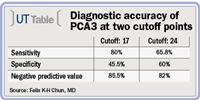Article
PCA3 data suggest new cutoffs, value vs. prostate-specific antigen alone
In the search for novel biomarkers for prostate cancer diagnosis, a urinary assay for prostate cancer gene 3 (PCA3) has emerged as a promising modality.

In a separate study, researchers from the University of Michigan, Ann Arbor, compared the ability of PCA3 and serum PSA to predict cancer detected by extended template biopsy.
The European group said its data confirmed the "highly discriminative" value of PCA3, but called for further studies to determine the most accurate cutoff. The Michigan team concluded that an assay based on PCA3 plus PSA improved prostate cancer prediction compared with PSA alone.

"Our results in this repeat biopsy cohort confirm the highly discriminative and informative value of PCA3," said first author Felix K-H Chun, MD, of the department of urology, University Hospital Hamburg-Eppendorf, Germany. "However, we agree with others investigating the diagnostic value of this marker that PCA3 should not be relied upon as a stand-alone assay, and that further, larger trials are needed to determine whether a PCA3 score represents a continuum of risk or which is the most appropriate cutoff value."
Participants in the multicenter study were enrolled between August 2006 and July 2007. Total PSA was assessed prior to attentive digital rectal examination, and a first-catch urine sample was collected after the DRE and analyzed using the PROGENSA PCA3 assay. The men in this study had a mean age of 65 years, mean PSA of 8.3 ng/mL, and 81% had a normal DRE. PCA3 scores ranged from 1.7 to 331.2, with a mean of 38.9. Prostate cancer was detected by repeat biopsy in 120 (28%) of the 435 men.
No correlation was seen between PCA3 and either PSA or prostate volume. However, comparison of men with and without biopsy-detected prostate cancer found significant differences between the two groups in PCA3 score and PSA.
To test various PCA3 cutoffs, the distribution of scores was first examined. The most discriminant value was 24, with an AUC of 0.627 determined using previously published methods. Based on ROC analysis, 17 was the most informative cut-off (AUC: 0.628). The PCA3 cutoff of 24 had a sensitivity, specificity, and negative predictive value of 65.8%, 60%, and 82%, respectively. Corresponding values for the PCA3 cutoff of 17 were 80%, 45.5%, and 85.5%, respectively.
"Previous studies have suggested PCA3 score cutoffs of 35, 43, and 58. Compared with those values, our cutoffs of 17 and 24 had a comparable AUC, but slightly lower specificity and negative predictive value. Thus, our results strongly suggest that the interpretation of the PCA3 value used as a cutoff or as a continuous variable needs further investigation," Dr. Chun said.
PCA3 adds value to PSA
In the University of Michigan study, researchers reported that an assay based on urinary PCA3 score plus serum PSA significantly improved prediction of prostate cancer compared with serum PSA alone in a pre-screened cohort of men referred for prostate biopsy. The population included 204 patients, seen between 2006 and 2007, who had urine specimens collected after attentive DRE and before undergoing ultrasound-guided extended template biopsy. The men had a mean age of 62 years, the majority were Caucasian (90%), and elevated PSA was the most common indication for biopsy (85%).

Navigating work-life balance: VUMC’s Family Planning for Surgeons Series

Investigators identify potential dual targets in prostate cancer



